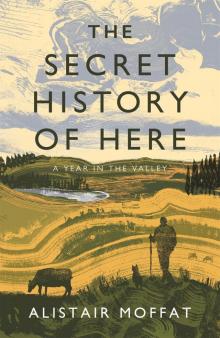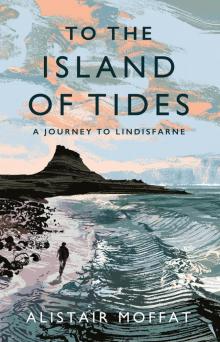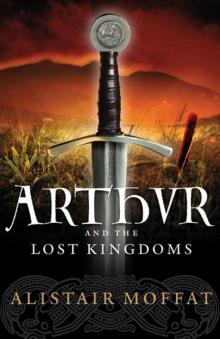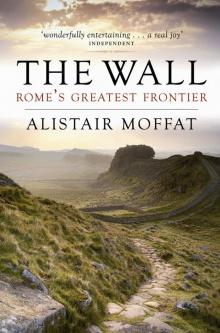- Home
- Alistair Moffat
The Wall Page 3
The Wall Read online
Page 3
TOFFS AND PLEBS
The Roman constitution evolved over an immense period and was very complex. It is the most likely extended explanation of why it was that Rome, an otherwise inconsequential central Italian settlement, came to be the pre-eminent European power for five hundred years, whose influence lasted long after its decline. Originally the city was governed by kings. Their tyrannical behaviour prompted a coup d’état, and from around 500 BC they were replaced by two elected magistrates known as consuls. Roman society remained rigidly hierarchical, and the consulship was at first the exclusive preserve of the patrician families, an aristocracy which had retained power despite the demise of the kings. They made up the membership of the Senate, originally an advisory council of elders (the name derives from senex, Latin for ‘an old man’). Other magistracies developed. Praetors were one step down from consuls, and below them aediles had legal power inside the city of Rome. The most junior magistrates were quaestors. As Rome grew, its patricians were forced to cede some power to the poorer citizens, the plebs. They could turn to a Tribune of the Plebs, who had the right to veto legislation. In times of emergency, one man could be appointed dictator, with absolute power for a term of six months. Religious affairs were in the care of the Pontifex Maximus, and below him and the others a forest of minor offices grew. The lawyer and orator Cicero developed the idea of the cursus honorum, a career path for ambitious men. But by then it was a bit too late. Once Augustus had established the power of the emperors, all of these magistracies became more or less honorific. The years were still named after the consuls who held office and, as with the modern honours system in Britain, people enjoyed fancy titles. Augustus obliged by having consuls elected for only a part of the year so that more men could hold the largely meaningless office.
All of this boundless, supposedly god-given ambition was founded on a remarkable phenomenon – the Roman army. One historian has characterised the history of the Republic and the Empire as the long, drawn-out and ultimately unsuccessful process of political institutions attempting to keep pace with the extraordinary and continuing string of victories won by Rome’s soldiers.
They won because they were different. Every army that Rome faced in western Europe and around the Mediterranean was largely recruited from amateurs, part-time soldiers with an obligation to fight when their aristocracy called upon them. Great hosts were mustered against the legions, often out-numbering them by many times, but they were comparatively poorly equipped, untrained, frightened farmers doing their duty. Rome’s army was professional. Killing was its business. Its soldiers were well paid, well trained, well armed and very experienced. When the VII and X Legions faced the warhorns, the hail of insults and the massed ranks of the British army in Kent in 55 BC, they will not have blinked. In Gaul and elsewhere the legionaries had seen it all before. If they kept their discipline, remembered their training and fought as a unit, they would cut these hollering savages to pieces. And, almost always, they did.
It was the long drive for empire which forged the Roman army into a highly professional and deadly force. After Africa, Spain, Greece and Asia Minor had been conquered, the urgent need for an efficient, and permanent, military capability was recognised by the great general Gaius Marius. In 107 BC he was elected consul and immediately abolished the outdated property qualification needed to fight in the army. From landless men and his own supporters, Marius began recruiting full-time soldiers. Many signed up for sixteen years, an unheard-of commitment, and in that time grew experienced and hardy. Training became mandatory, equipment better and standardised, and clear organisation was imposed.
Like all talented tacticians, Marius saw mobility as a key to victorious campaigning. From the moment they joined their units, Roman soldiers were trained to march. For four months centurions put them through intensive square-bashing so that they instinctively marched in step and reacted instantly to commands. In battle this sort of collective conditioning could be crucial. To arrive at the battlefield quickly and in good order, recruits were put through a punishing schedule of route marching. Once trainee legionaries could march 30 kilometres in five hours, they were appalled to discover that they needed to maintain the same speed – but in full armour and carrying all their kit and equipment. On average this weighed about 50 kilograms. Before Marius’ reforms, the Roman army had been followed – and slowed down – by a baggage train of mules. After 107 BC the legionaries carried everything and began to call themselves Marius’ Mules.
Weaponry evolved and adapted at the same time. Most conscript armies, especially those raised amongst the Celtic peoples of Europe, used their large numbers in a simple but effective tactic – the furious charge. It worked for millennia, even after the introduction of muskets and cannons, and was last seen on British soil as late as 1746 at Culloden Moor. The Roman response was the javelin. Carried by each legionary, it had a long, slim and very sharp point attached to a wooden haft. As the enemy ran within range, a dense volley was thrown. Javelins broke up a charge but were not accurate enough to halt it. By the time survivors reached Roman battlelines, shields had locked together and the short sword known as the gladius was drawn. No more than 60 centimetres long, it was much more effective in close-quarter fighting than the long, slashing sword used by Celtic warriors. Thrusting, stabbing, pushing and staying together in a tight formation, the legions literally rolled over their enemies. Winning again and again, marching long distances quickly, Roman armies dominated western European warfare for 500 years.
CARRY ON, SERGEANT
Roman soldiers spent most of their time not fighting. Many were skilled tradesmen able to apply themselves to a wide variety of tasks. The most hated peace-time job was road-building. And in the early years of the province of Britain there was a great deal of that to do. Many men got out of breaking roadstone, digging ditches and laying paving by developing other skills and no doubt sucking up to officers. For example, if they found an inside job as a clerk, they moved from being a mere miles, or soldier, to becoming an immunis. The next step up the ladder was to the rank of principales, the lance-corporals of the Roman army. That meant one and a half times the pay of, say, an orderly in a century. Standard-bearers and optiones (second-in-command of a century – roughly equivalent to a sergeant) were on double pay and centurions got even more. In a legion of roughly 4,800 men there were ten cohorts. The first contained five double centuries and the remaining nine had six centuries each. The best that a common soldier could do in his legion was to rise to the rank of primus pilus, literally, the first spear, and in reality the senior centurion. Aristocrats held a monopoly on high command. The legate who led a legion was usually a senator, and his six staff officers were men from patrician families setting out on a career.
As professional soldiers who trained, lived, fought and died together, the legionaries developed a tremendously powerful esprit de corps. The sort of bravery shown by the standard-bearer of the X Legion on the Kentish beaches was by no means unusual. Three years later, Caesar’s men led an abortive attack in the Gaulish rebellion led by Vercingetorix. At Gergovia they were forced to retreat downhill and could have suffered terrible casualties. But the centurions of the VII and X Legions made a line and fought a brave rearguard action to allow their men down the slopes to safety. Forty-six centurions fell, but they prevented a disaster. Almost always the toughest soldiers in a legion and used to leading from the front, these men stood fast on the slopes at Gergovia, prepared to buy the safety of their comrades with their lives.
After the Marian reforms, loyalty became an immensely powerful bond, but it was loyalty to their generals which mattered to soldiers, far more than any loyalty to Rome itself. The state paid and equipped their legionaries but crucially, and catastrophically, refused to make any provision for their discharge or retirement. Instead commanders like Marius, Caesar, Pompey and Crassus bound their soldiers to themselves personally by promising to provide for each one of them when their army service was over. This was always expensi
ve, and the need for cash to pay for veterans’ retirement, land for them to settle on and booty to help them enrich themselves was one of the most important motives behind continuing conquest.
Roman law was surprisingly inexact when it came to be applied to what the historian Tacitus called the pretium victoriae, the wages of victory. This vagueness allowed Caesar and others to become fabulously wealthy as they, nominally at least, acted in the interests of the state. When Gaul was overrun, fortunes were made and as the legions advanced they knew that military success would bring them booty now and a guaranteed retirement later. Their success bound them ever more closely to the likes of Caesar and also gave them powerful incentives to fight hard and earn the wages of victory.
Momentum developed naturally. It is difficult to discern much in the way of coherent policy from the Senate in Rome. The Empire expanded through accident and opportunism, but also because great men wished to become even greater. In Rome there was no meaningful distinction between soldiers and politicians. Senators led legions, generals were senators. Military and political success were largely the same thing. Julius Caesar needed to turn his attention to Britain because he had conquered Gaul. Like a shark he had constantly to move forward.
The reaction in Rome to what amounted to little more than an armed reconnaissance in 55 BC, and the loose ends left when the legions departed quickly, meant that Caesar had to return to Britain. A year was a very long time in politics, and a fresh expedition, perhaps a sustained conquest of the fabled island, would keep his name in the limelight. And, to feed Caesar’s coffers, there might be more tangible rewards. The imperial economy had an insatiable appetite for slaves, and war always produced plenty. Britain had mineral wealth: tin certainly, lead, and perhaps gold and silver. Corn was less shiny but always welcome to the quartermasters of the huge army in Gaul and the Rhine basin. But in truth it was prestige, the promise of glory, which drew Caesar back to the shores of the Channel.
TALKING MACHINES
The unseen, unheard and rarely recorded hands, muscles and brains which underpinned Roman society belonged to the vast number of slaves who lived all over the Empire. In Italy alone in the first century AD, it is thought that there were more than 3 million. With no rights of any kind, they were treated as objects, an instrumentum vocale, a talking tool, or, more brutally, a res, a thing. On Greek pottery, their distinctive shaved heads contrast with the aristocrats they are serving. A slave collar found around the neck of a skeleton carried the message ‘If captured return me to Apronianus, minister in the imperial palace . . . for I am a runaway slave.’ The Roman legal system only allowed slaves to give evidence if they had first been tortured. Otherwise what they said was thought to be inherently unreliable. Roman soldiers had slaves, and Britain was seen as an excellent source. A beautifully made iron chain with collars attached was found at Llyn Cerrig Bach on Anglesey. It had been designed to restrain a chain gang of five and it shows that native British aristocrats also had slaves.
During the winter some tactical lessons were learned. Transports were designed differently. More than 600 were built with a shallow draught to allow them to be beached more easily. To augment their sails and make them more manoeuvrable, banks of oars were added on each side. These modifications were important because the new expedition was planned on an altogether different scale. Five legions and 2,000 cavalry troopers would cross the Ocean in the summer of 54 BC. And Britain’s defenders could not hope to match such a force once they had gained the safety of the shore. But they had to gain it without all the problems of the previous year. Significantly several private vessels were to accompany the fleet. Merchants perhaps, people who hoped to profit from an assured success.
Archaeologists have not yet found the site of Caesar’s second landing, but it is likely to have been close to the first, on the beaches near Deal. Once ashore, Caesar attacked immediately. Having learned that the British had retreated inland, probably at the approach of such a large invasion force, he pursued them hard. With four legions, including the VII and the X, more than 20,000 men and 1,700 cavalry, Caesar at last found part of the British army drawn up behind a river. It was probably the Stour near modern Canterbury. The bulk of the native forces had taken up a defensive position behind the ramparts of a hillfort, almost certainly at Bigbury.
After his cavalry had scattered the skirmishers along the riverbank, Caesar launched the VII Legion in an assault on the fort. Under the protection of the testudo formation, where the legionaries locked their shields over their heads and sides to form a protective shell, the VII built a ramp up to the walls. After a sharp attack, the British fled. Sending his cavalry in only a brief pursuit, Caesar had his men build a marching camp. From there they began the business of subduing the countryside.
So far, so good. But familiar problems surfaced back at the base-camp on the Kentish coast. Despite the redesign of the transports and all the hard-learned lessons of the previous expedition, the same mistakes were made. Left riding at anchor out in the Channel roadsteads, the transport fleet was badly damaged in a storm. Belatedly, a huge ship-camp was dug and the fleet beached well above the high tideline. The new fort took ten days to raise.
Meanwhile the British kings had held a council and managed to suppress their differences in the face of the Roman threat. Cassivellaunus was appointed war-leader. The conflict quickly intensified and, as Caesar advanced through Kent towards the Thames, the British attacked at every opportunity, but were not tempted into pitched battle. When the Roman army halted at the end of a day’s march, Cassivellaunus saw his chance.
The digging of a temporary marching camp in hostile countryside was absolutely essential, but it presented a short period of dangerous exposure – despite elaborate precautions. As evening approached and the army halted, most of the legionaries deployed in battle order, facing the most likely direction of threat. Behind this protective screen, others dug a deep ditch (three and a half metres wide and two and a half deep) and built a rampart from the upcast. Each man carried two stakes sharpened at either end and with a narrow waist which allowed them to be easily tied together. Made from hard-wearing oak, the stakes might have been lashed in threes and set on top of the rampart like large caltrops. If each were tied to its neighbours, these spikey clusters would have made a very formidable obstacle to an enemy charge. Once one side of the camp was complete, the legionaries in battle order moved behind it, and more men could be released to complete the remaining three as quickly as possible.
Cassivellaunus’ soldiers attacked at that moment. And it was only with the aid of reinforcements that they were beaten back. But it was a hard fight, and one of Caesar’s senior officers, a tribune, was killed. Pressing on almost immediately through northern Kent, the Roman army arrived on the banks of the River Thames, their first really formidable natural obstacle. It is likely that Cassivellaunus was king of the Catuvellauni, and the river flowed through the heart of his territory. No doubt with local help, Caesar’s scouts found a ford, possibly a place now in the centre of modern London. When the Romans waded across the Thames, swept resistance aside and advanced northwards, the British commander changed tactics. Wisely refusing a set-piece battle (and disbanding the bulk of his army – it was harvest-time), he used chariots to skirmish and drove flocks and herds out of the line of march and beyond the reach of legionary foragers.
At this moment, when a long process of attrition threatened and lines of communication with base-camp seemed set to stretch to breaking point, Caesar brought domestic British politics into play. Some time before the invasion, Cassivellaunus had had the king of the Trinovantes killed. Their territory neighboured his own, and the removal of their ruler probably expanded his kingdom into East Anglia. The heir to the Trinovantian throne, Mandubracius, had fled to Gaul to seek Caesar’s support, and appears to have accompanied the Roman army in 54 BC. Once across the Thames, it seemed the right time to play this political card. With an agreement to restore Mandubracius, and presumably throw off Cat
uvellaunian control, the Trinovantes surrendered to Caesar, supplying hostages and much needed food and supplies.
Cassivellaunus countered with an audacious move. Showing that he had both good communications and a long military reach, he ordered four Kentish kings to combine forces and attack the Roman base-camp on the Channel shore. But they failed. Left to guard the precious transports, Quintus Arius and his men defended the ship-camp successfully and inflicted many casualties on the British.
INFANTS
In Western Europe a tradition of hierarchy in battle has grown up and it places the infantry, the foot soldiers, the squaddies, in a lowly position. This is almost entirely a consequence of the rise in the importance of cavalry, especially the heavy cavalry of the Middle Ages. It continued into the Victorian period, and even when the Light Brigade charged into the wrong valley it was considered somehow glorious. If the infantry had marched on the Russian guns, it would just have been thought daft. This pecking order is summed up by the word ‘infantry’. It is cognate to enfant in French, infante in Italian and in essence was a term for the boys, too young or too poor to afford a horse. This attitude would have made tough old centurions smile. For Rome the infantry were the elite, the core of the army, and flapping around the wings were the horse-boys, the cavalry.
Meanwhile Rome’s new Trinovantian allies had betrayed the location of Cassivelluanus’ headquarters to Caesar. Once they had broken through the defences – which appear to have been long and difficult to man – his soldiers were no doubt delighted to find herds of cattle.
It was enough. Cassivellaunus sued for peace, and once again Commius mediated. Time was pressing hard on Caesar: it was late September, and his commanders in Gaul had sent word that rebellion was in the air. Punitive terms would take too long and might be difficult to enforce. Hostages, an annual tribute and the security of the Trinovantes were quickly agreed, and the Roman army embarked once more to brave the dangers of the Ocean.

 The Secret History of Here
The Secret History of Here The Night Before Morning
The Night Before Morning To the Island of Tides
To the Island of Tides Arthur and the Lost Kingdoms
Arthur and the Lost Kingdoms Britain’s Last Frontier
Britain’s Last Frontier The Faded Map: The Lost Kingdoms of Scotland
The Faded Map: The Lost Kingdoms of Scotland The Wall
The Wall